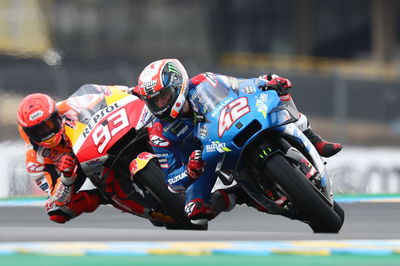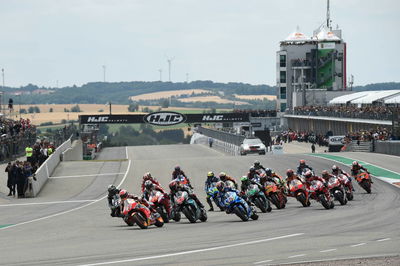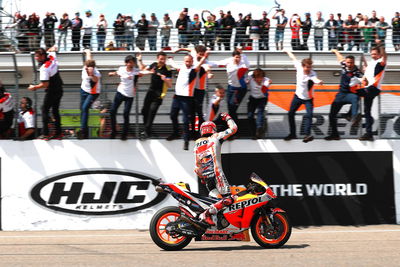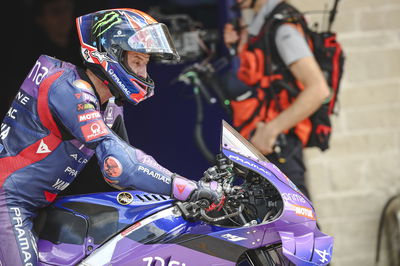An 'urban' MotoGP race? Marquez, Mir, Rins give their opinions

While this weekend's German MotoGP will be held on the shortest and slowest circuit on the calendar, the original Sachsenring was a fearsome 8.6-kilometre track laid out on public roads.
It was venue for the then East German Grand Prix from 1961 to 1972, with the first 125cc race won by local hero Ernst Degner using MZ's advanced two-stroke technology (the secrets of which he would take to Suzuki after defecting to the west).
When the World Championship eventually returned to the Sachsenring in 1998 it was on a very different permanent 3.5km racetrack (later extended to 3.671km) which retains the original finish line from the era of public roads.
While MotoGP's safety evolution has seen public roads replaced by permanent facilities, Indonesia's new 'Mandalika Street Circuit' is seeking a modern interpretation that combines them both.
Starting from a blank sheet of paper, the track - set to make its MotoGP debut in 2022 - has been designed to meet all the safety standards of a modern permanent circuit, but will be converted into public road use for those staying on the tourist island outside of a grand prix event.
But will MotoGP ever be able to race inside a major city, thus bringing the sport to the fans - rather than the other way around - in a way that F1 currently does for the likes of Monaco and Baku?
The most realistic chance from a safety perspective would be to follow the format of another F1 street circuit, Melbourne's Albert Park, and create a MotoGP track within an open space in the heart of an urban area.
“Open road Grand Prix circuits seem unthinkable today due to the kind of asphalt and the lack of escaping areas at turns, I mean in terms of safety," said eight-time world champion Marc Marquez.
"Riders racing on public roads in the past had great merit because they raced in much lower safety conditions than MotoGP riders today."
But the Repsol Honda rider didn't completely discount the idea.
"If safety on a street circuit could be guaranteed today, with good escape areas in case of crashing or having a braking mistake, it could be considered. I think there is a project about that, but I don't know much about it at this moment," he said.
"Why could it not actually be done?
"If we could race in the future at an urban racetrack it would be nice, but it takes a lot in terms of safety, with long enough escaping areas and that would be really tricky."
Younger brother Alex Marquez underlined that it would be 'unthinkable' to race a modern MotoGP prototype on the public road circuits of the past, but is also open to the idea of a modern 'urban' circuit.
“These open road circuits from the 1960s and 1970s left a lot of spectacular images, but today it would be unthinkable to race on those open road circuits," said the LCR Honda rider.
"Luckily, safety has improved a lot on permanent tracks and is getting higher and higher. It was a very different time from today, but also beautiful.
"If the same level of safety as closed circuits could be achieved, why not maybe to race on properly conditioned open or urban tracks?
"Apparently, next year we could go racing to Indonesia, which has a circuit with part of its urban layout but with a high level of safety."

Suzuki's Alex Rins agreed that it all comes down to safety, but would like to see more 'special' circuits on the calendar.
“I think the Grand Prix circuits on public roads used to be spectacular, but it seems very difficult to me that nowadays you could race on a public road circuit with the current bikes and the speed we are going at. Although safety has improved a lot, so I don't think it can be done.
"In the event that safety conditions were as high as they are on permanent tracks, of course I would like to race at those tracks. Unfortunately, we know very well that zero risk does not exist, but I still like circuits that have something that makes them "special", like Austin or Phillip Island.
"F1 with its GPs in Monaco or Baku has done very well on this side."
Team-mate and reigning world champion Joan Mir is also in awe of the public road racing in grand prix, but believes it belongs firmly in the past.
“I have never seen races on public road circuits, but I have seen photos and some videos and it is impressive to see the racing conditions many years ago at the old Sachsenring," he said.
"I don't think that you can get the same high safety level on public roads as it is done at permanent circuits. There are many obstacles and I consider it dangerous, especially considering the power of a MotoGP bike."
While he has never raced on pubic roads, Marc Marquez has a strong record at permanent tracks with a similar character; short, tight and twisty.
"I have always liked short racetracks such as Sachsenring, Laguna Seca or Jarama," said Marquez, undefeated at the Sachsenring since 2010.
"Some riders prefer long circuits because they are more entertaining, have more turns and take fewer laps, but I have always liked short circuits.
"They demand a special technique and require a higher level of concentration. You have to fight for every thousandth, as lap times are usually very tight. That's why I like tracks like Sachsenring or Laguna Seca.
"I have never ridden a motorcycle at Jarama. I did on a car and it’s just a beautiful and entertaining circuit."

But brother Alex and fellow Estrella Galicia-backed rider Mir prefer the bigger, faster tracks.
"I honestly prefer longer and faster circuits," said Alex. "However, our bike seems to work on small, fun circuits and I tend to do better too, so hopefully we can do well from the start. In the end, if you feel good at it, it doesn't matter if it's a long or a short track."
"Talking about permanent tracks, I prefer the longer ones, with fast and linked corners, such as Mugello, Philip Island or Assen," said Mir. "Sachsenring seems a bit small for a MotoGP bike, but you always find fans with a great passion.”
After losing its event due to Covid restrictions last season, Free Practice at the 'new' Sachsenring starts on Friday morning.












